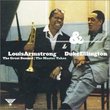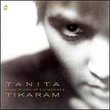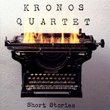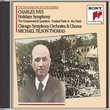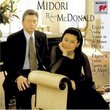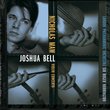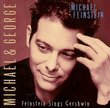| All Artists: Alan Hovhaness, Keith Brion, Royal Scottish Academy of Music and Drama Wind Orchestra Title: Hovhaness: Symphonies Nos. 4, 20 & 53; The Prayer of St. Gregory Members Wishing: 0 Total Copies: 0 Label: Naxos American Original Release Date: 1/1/2005 Re-Release Date: 11/15/2005 Genre: Classical Styles: Forms & Genres, Concertos, Historical Periods, Modern, 20th, & 21st Century, Instruments, Brass, Symphonies Number of Discs: 1 SwapaCD Credits: 1 UPC: 636943920725 |
Search - Alan Hovhaness, Keith Brion, Royal Scottish Academy of Music and Drama Wind Orchestra :: Hovhaness: Symphonies Nos. 4, 20 & 53; The Prayer of St. Gregory
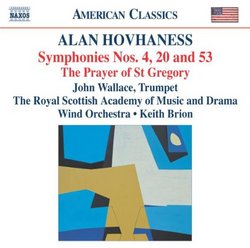 | Alan Hovhaness, Keith Brion, Royal Scottish Academy of Music and Drama Wind Orchestra Hovhaness: Symphonies Nos. 4, 20 & 53; The Prayer of St. Gregory Genre: Classical
|
Larger Image |
CD DetailsSimilarly Requested CDs
|
CD ReviewsHovhaness' Wind Symphonies Robin Friedman | Washington, D.C. United States | 11/25/2005 (5 out of 5 stars) "The late Alan Hovhaness (1911 - 2000)has received considerable popular attention but too little critical appreciation. Hovhaness was a prolific composer of 67 symphonies and over 400 works in a variety of forms. He wrote a great deal of music for band, and his output includes eight wind symphonies. Three of these symphonies are offered on this CD. Keith Brion conducts the Royal Scottish Academy of Music and Drama Wind Orchestra. Brion first conducted Hovhaness' wind music in 1964 with a high school band and recorded an all-Hovhaness disk with Gerard Schwartz on the trumpet in 1969. He has also made extensive recordings for Naxos of the music of John Phillip Sousa. Hovhaness' symphonies are generally short and programmatic. The three wind symphonies on this CD emphasize the mystical, spiritual music of the composer. They consist of long choral passages for brass intertwined with solos for many different wind instruments, and for gongs, bells, cymbals, and drums. Much of the music, for the solos in particular, is modal in character, and it is contrasted with tonal passages in the larger ensembles. (Jean Sibelius did the same thing at times and Sibelius was a great influence on Hovhaness.) Hovhaness makes extensive use of counterpoint. The music is, and was composed to be, immediately accessible to a broad audience. The three movement Symphony no. 4, opus 165, probably Hovhaness' best-known wind work, was composed in 1958. It contrasts brass chorales for trombone and trumpet with long solo themes in the bass clarinet and bassoon. It closes with an extended fugue. The unusual second movement features a haunting solo for xylophone extending the length of the music. It reminded me of a Milt Jackson solo for the Modern Jazz Quartet, which was active at the time this work was composed. The final opens with an extended brass chorale followed by solos for trumpet and winds. Bells and gongs give a mystical character to this symphony throughout. Hovhaness' three -movement symphony no. 20, "Three Journeys to a Holy Mountain" opus 223 dates from 1969 and was one the composer's works commissioned and performed first by a high school band. Each movement represents a pilgrimage. The tripartite first movement opens with a clarinet solo, followed by an English horn solo, and a long, lyrical climactic section. The second movement begins with a long solo for alto saxophone, and the band gradually joins in over a low droning theme and the roll of drums. The finale features a brass chorale and fugue. Here again percussion and chimes add much to this piece. The final symphony on this disk, the two-movement "Star Dawn" opus 377 dates from 1983. Hovhaness apparently was fascinated by the possiblity of space travel, an interest I find it best to disregard in hearing the music. Chorale sections are contrasted with long, flowing solo passages for clarinet in the first movement. A drum-roll opens the second movement followed by a long reedy solo and a fugual close. The accompaniment of bells is to represent the stars or, perhaps,human yearning. The CD includes two short Hovhaness works for band. The "Prayer of Saint Gregory" is a short piece Hovhaness arranged from an earlier composition for trumpet solo, played here by John Wallace, and band The trumpet solo predominates in this brief work with a meditative, searching character. The other short work, "Return and Rebuild the Desolate Places" also features John Wallace on the trumpet. The work opens with a piercing trumpet solo, followed by a loud helter-skelter passage for the ensemble. The second movement also is lead by the trumpet and is a call to rebuild the world from chaos. This CD and its earlier companion will introduce the listener to the music of Alan Hovhaness. I understand that further releases of Hovhaness' music may be in the offing on Naxos. Naxos is performing a real service to lovers of music in its ongoing "American Classics" series. Robin Friedman" Hovhaness for Winds J Scott Morrison | Middlebury VT, USA | 12/03/2005 (4 out of 5 stars) "I would urge you to read Robin Friedman's excellent review dated November 25, 2005; his descriptions of the music are excellent and give a pretty good idea of what to expect, especially if you are not that familiar with Hovhaness's music. Hovhaness wrote a great deal of music, and like some other very prolific composers (Milhaud comes to mind) some of Hovhaness's music treads a thin line between real merit and kitsch. For instance, the first of the 'Three Journeys to a Holy Mountain' sounds very much like clichéd snake-charmer music to me. That said, I found most of this disc to be extremely enjoyable. Much of it is based on chorale harmonies in the brass with occasional fanfare-like episodes, plus very imaginative use of percussion, both tuned and untuned. And, of course, there is much use of Near Eastern melorhythms. By far the most amazing thing in this program is the noisy eruption shortly after the trumpet's oration in the first movement of 'Return and Rebuild the Desolate Place.' If one tried to imagine the cacophony of hell, one couldn't do better than this. And it sounds for all the world as if it is aleatoric, with each instrument going its satanic way, each one slowly dropping out until all that's left are sinister low growling trombone glisses. Wow! What an imagination Hohvaness had to come up with this! The performances by the Royal Scottish Academy of Music and Drama Wind Orchestra (what an ungainly name!), which I take to be a student group, is quite good. Solo trumpet work is done beautifully by John Wallace, as one would expect by this fine Scots trumpeter who has recently become the principal of the Academy. I would suggest that whoever listens to this CD make sure not to listen to the whole CD in one sitting, but rather to each piece on its own. Otherwise there is some tendency for it to all run together and sound alike. Close listening, however, reveals that each piece has its own charms. Scott Morrison" Never were there better compositions or performances. Patrick W. Crabtree | Lucasville, OH USA | 01/04/2008 (5 out of 5 stars) "I listen to this CD EVERY night, along with Hovhaness's Saint Vartan Symphony. These compositions are phenomenal!
Alan Hovhaness, (1911-2000), an American composer of Armenian heritage, spent a lot of time in the Middle East and in the Orient; a bit of that flavour comes through on this fine recording, mostly in regard to the subtle bells which are manifest in the work. No, this isn't 'Asian Music' by any means -- in fact, if you were unaware of Hovhaness's Eastern studies then you would probably have difficulty in putting your finger on exactly what makes his work so beautifully unique to all other Classical Music. All the works on this CD are brilliantly played by The Royal Scottish Academy of Music and Drama, Keith Brion, conducting, with John Wallace on trumpet. Wallace's clear artistry on these masterpieces yield an ambiance of profoundly mysterious atmosphere which one would expect in association with Scriabin or, perhaps more melodically, Debussy. The "Prayer of Saint Gregory" is an especially moving piece but it's all just great. One gets a sense of Medieval England, somehow positively influenced by Hovhaness's Eastern musical manifestations. Congratulations to Naxos for a bright, clear recording with superb emphasis on both the high and the low ranges of instrumentation. Don't miss a chance to hear these fine compositions, brilliantly performed, at a steal of a price, folks." |

 Track Listings (11) - Disc #1
Track Listings (11) - Disc #1